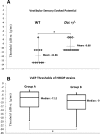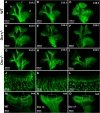Genome-Wide Association Analysis Identifies Dcc as an Essential Factor in the Innervation of the Peripheral Vestibular System in Inbred Mice
- PMID: 27539716
- PMCID: PMC5023540
- DOI: 10.1007/s10162-016-0578-4
Genome-Wide Association Analysis Identifies Dcc as an Essential Factor in the Innervation of the Peripheral Vestibular System in Inbred Mice
Abstract
This study aimed to investigate the genetic causes of vestibular dysfunction. We used vestibular sensory-evoked potentials (VsEPs) to characterize the vestibular function of 35 inbred mouse strains selected from the Hybrid Mouse Diversity Panel and demonstrated strain-dependent phenotypic variation in vestibular function. Using these phenotypic data, we performed the first genome-wide association study controlling for population structure that has revealed two highly suggestive loci, one of which lies within a haplotype block containing five genes (Stard6, 4930503L19Rik, Poli, Mbd2, Dcc) on Chr. 18 (peak SNP rs29632020), one gene, deleted in colorectal carcinoma (Dcc) has a well-established role in nervous system development. An in-depth analysis of Dcc-deficient mice demonstrated elevation in mean VsEP threshold for Dcc (+/-) mice (-11.86 dB) compared to wild-type (-9.68 dB) littermates. Synaptic ribbon studies revealed Dcc (-/-) (P0) and Dcc (+/-) (6-week-old) mice showed lower density of the presynaptic marker (CtBP2) as compared to wild-type controls. Vestibular ganglion cell counts of Dcc (-/-) (P0) was lower than controls. Whole-mount preparations showed abnormal innervation of the utricle, saccule, and crista ampullaris at E14.5, E16.5, and E18.5. Postnatal studies were limited by the perinatal lethality in Dcc (-/-) mice. Expression analyses using in situ hybridization and immunohistochemistry showed Dcc expression in the mouse vestibular ganglion (E15.5), and utricle and crista ampullaris (6-week-old), respectively. In summary, we report the first GWAS for vestibular functional variation in inbred mice and provide evidence for the role of Dcc in the normal innervation of the peripheral vestibular system.
Keywords: Hybrid Mouse Diversity Panel; axonal migration; crista; deleted in colorectal carcinoma (Dcc); genome-wide association study; utricle; vestibular ganglia; vestibular sensory evoked potential; vestibular system.
Figures








Similar articles
-
Developmental expression of Kcnq4 in vestibular neurons and neurosensory epithelia.Brain Res. 2007 Mar 30;1139:117-25. doi: 10.1016/j.brainres.2006.12.087. Epub 2007 Jan 8. Brain Res. 2007. PMID: 17292869 Free PMC article.
-
Vestibular dysfunction, altered macular structure and trait localization in A/J inbred mice.Mamm Genome. 2015 Apr;26(3-4):154-72. doi: 10.1007/s00335-015-9556-0. Epub 2015 Feb 3. Mamm Genome. 2015. PMID: 25645995 Free PMC article.
-
[Traverse connectivity of innervation in the vestibular sensory epithelium].Zhonghua Er Bi Yan Hou Ke Za Zhi. 1999 Jun;34(3):160-2. Zhonghua Er Bi Yan Hou Ke Za Zhi. 1999. PMID: 12764808 Chinese.
-
[Evoked vestibular myogenic potentials: anatomic-physiologic aspects and clinical application].Zh Nevrol Psikhiatr Im S S Korsakova. 2011;111(2):84-9. Zh Nevrol Psikhiatr Im S S Korsakova. 2011. PMID: 21510105 Review. Russian. No abstract available.
-
When, where, and why should we look for vestibular dysfunction in people with diabetes mellitus?Front Rehabil Sci. 2024 Jan 11;4:1306010. doi: 10.3389/fresc.2023.1306010. eCollection 2023. Front Rehabil Sci. 2024. PMID: 38273862 Free PMC article. Review.
Cited by
-
Genomewide Association Study Identifies Cxcl Family Members as Partial Mediators of LPS-Induced Periodontitis.J Bone Miner Res. 2018 Aug;33(8):1450-1463. doi: 10.1002/jbmr.3440. Epub 2018 May 22. J Bone Miner Res. 2018. PMID: 29637625 Free PMC article.
-
Wiring the senses: Factors that regulate peripheral axon pathfinding in sensory systems.Dev Dyn. 2023 Jan;252(1):81-103. doi: 10.1002/dvdy.523. Epub 2022 Aug 30. Dev Dyn. 2023. PMID: 35972036 Free PMC article. Review.
References
MeSH terms
Substances
Grants and funding
LinkOut - more resources
Full Text Sources
Other Literature Sources
Molecular Biology Databases
Miscellaneous

